Chapter 8 Application Of Integrals
One should study Mathematics because it is only through Mathematics that nature can be conceived in harmonious form. - BIRKHOFF
8.1 Introduction
In geometry, we have learnt formulae to calculate areas of various geometrical figures including triangles, rectangles, trapezias and circles. Such formulae are fundamental in the applications of mathematics to many real life problems. The formulae of elementary geometry allow us to calculate areas of many simple figures. However, they are inadequate for calculating the areas enclosed by curves. For that we shall need some concepts of Integral Calculus.
In the previous chapter, we have studied to find the area bounded by the curve $y=f(x)$, the ordinates $x=a$, $x=b$ and $x$-axis, while calculating definite integral as the limit of a sum. Here, in this chapter, we shall study a specific application of integrals to find the area under simple curves, area between lines and arcs of circles, parabolas and

A.L. Cauchy (1789-1857) ellipses (standard forms only). We shall also deal with finding the area bounded by the above said curves.
8.2 Area under Simple Curves
In the previous chapter, we have studied definite integral as the limit of a sum and how to evaluate definite integral using Fundamental Theorem of Calculus. Now, we consider the easy and intuitive way of finding the area bounded by the curve $y=f(x), x$-axis and the ordinates $x=a$ and $x=b$. From Fig 8.1, we can think of area under the curve as composed of large number of very thin vertical strips. Consider an arbitrary strip of height $y$ and width $d x$, then $d A$ (area of the elementary strip) $=y d x$, where, $y=f(x)$.

This area is called the elementary area which is located at an arbitrary position within the region which is specified by some value of $x$ between $a$ and $b$. We can think of the total area A of the region between $x$-axis, ordinates $x=a, x=b$ and the curve $y=f(x)$ as the result of adding up the elementary areas of thin strips across the region PQRSP. Symbolically, we express
$$ \mathrm{A}=\int _{a}^{b} d \mathrm{~A}=\int _{a}^{b} y d x=\int _{a}^{b} f(x) d x $$
The area $A$ of the region bounded by the curve $x=g(y), y$-axis and the lines $y=c$, $y=d$ is given by
$$ \mathrm{A}=\int _{c}^{d} x d y=\int _{c}^{d} g(y) d y $$
Here, we consider horizontal strips as shown in the Fig 8.2

Fig 8.2
Remark If the position of the curve under consideration is below the $x$-axis, then since $f(x)<0$ from $x=a$ to $x=b$, as shown in Fig 8.3, the area bounded by the curve, $x$-axis and the ordinates $x=a, x=b$ come out to be negative. But, it is only the numerical value of the area which is taken into consideration. Thus, if the area is negative, we take its absolute value, i.e., $|\int_a^{b} f(x) d x|$.

Fig 8.3
Generally, it may happen that some portion of the curve is above $x$-axis and some is below the $x$-axis as shown in the Fig 8.4. Here, $A_1<0$ and $A_2>0$. Therefore, the area A bounded by the curve $y=f(x), x$-axis and the ordinates $x=a$ and $x=b$ is given by $A=|A_1|+A_2$.
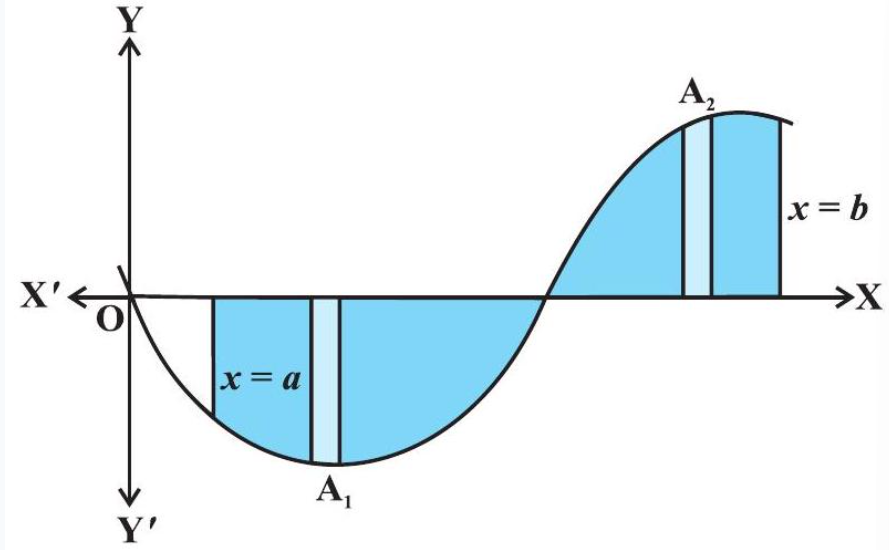
Fig 8.4
Example 1 Find the area enclosed by the circle $x^{2}+y^{2}=a^{2}$.
Solution From Fig 8.5, the whole area enclosed by the given circle $=4$ (area of the region AOBA bounded by the curve, $x$-axis and the ordinates $x=0$ and $x=a$ ) [as the circle is symmetrical about both $x$-axis and $y$-axis]
$$ \begin{aligned} & =4 \int_0^{a} y d x \text{ (taking vertical strips) } \\ & =4 \int_0^{a} \sqrt{a^{2}-x^{2}} d x \end{aligned} $$
Since $x^{2}+y^{2}=a^{2}$ gives $\quad y= \pm \sqrt{a^{2}-x^{2}}$
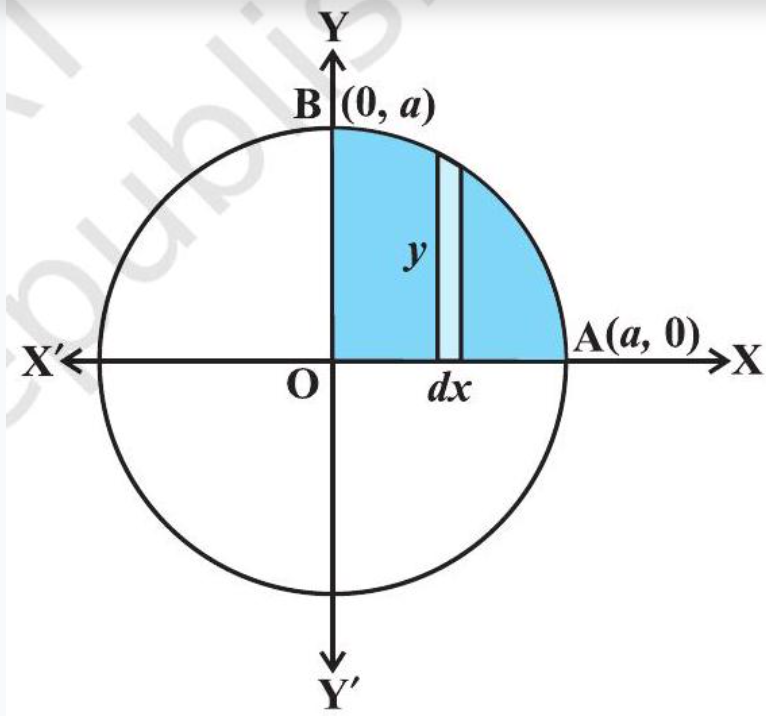
Fig 8.5
As the region AOBA lies in the first quadrant, $y$ is taken as positive. Integrating, we get the whole area enclosed by the given circle
$ \begin{aligned} & =4[\frac{x}{2} \sqrt{a^{2}-x^{2}}+\frac{a^{2}}{2} \sin ^{-1} \frac{x}{a}]_0^{a} \\ & =4[(\frac{a}{2} \times 0+\frac{a^{2}}{2} \sin ^{-1} 1)-0]=4(\frac{a^{2}}{2})(\frac{\pi}{2})=\pi a^{2} \end{aligned} $
Alternatively, considering horizontal strips as shown in Fig 8.6, the whole area of the region enclosed by circle
$ \begin{aligned} & =4 \int_0^{a} x d y=4 \int_0^{a} \sqrt{a^{2}-y^{2}} d y \text{(Why?)} \\ & =4[\frac{y}{2} \sqrt{a^{2}-y^{2}}+\frac{a^{2}}{2} \sin ^{-1} \frac{y}{a}]_0^{a} \\ & =4[(\frac{a}{2} \times 0+\frac{a^{2}}{2} \sin ^{-1} 1)-0] \\ & =4 \frac{a^{2}}{2} \frac{\pi}{2}=\pi a^{2} \end{aligned} $
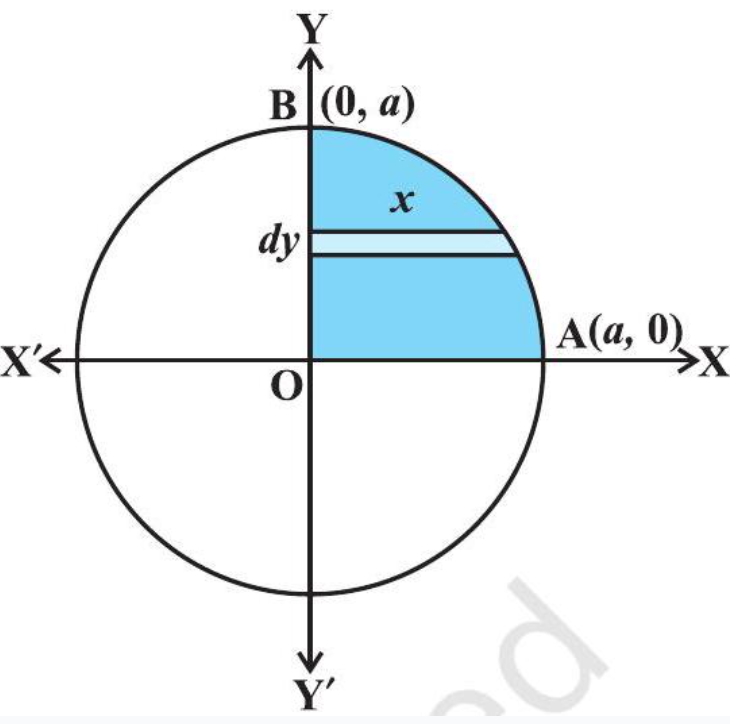
Fig 8.6
Example 2 Find the area enclosed by the ellipse $\frac{x^{2}}{a^{2}}+\frac{y^{2}}{b^{2}}=1$
Solution From Fig 8.7, the area of the region $ABA^{\prime} B^{\prime} A$ bounded by the ellipse
$=4(\begin{matrix} \text{ area of the region } A O B A \text{ in the first quadrant bounded } \\ \text{ by the curve, } x-\text{ axis and theordinates } x=0, x=a\end{matrix} )$
(as the ellipse is symmetrical about both $x$-axis and $y$-axis)
$=4 \int_0^{a} y d x \quad$ (taking vertical strips)
Now $\frac{x^{2}}{a^{2}}+\frac{y^{2}}{b^{2}}=1$ gives $y= \pm \frac{b}{a} \sqrt{a^{2}-x^{2}}$, but as the region AOBA lies in the first quadrant, $y$ is taken as positive. So, the required area is
$ \begin{aligned} & =4 \int _{0}^{a} \frac{b}{a} \sqrt{a^{2}-x^{2}} d x \\ & =\frac{4 b}{a}\left[\frac{x}{2} \sqrt{a^{2}-x^{2}}+\frac{a^{2}}{2} \sin ^{-1} \frac{x}{a}\right] _{0}^{a} \text { (Why) } \\ & =\frac{4 b}{a}\left[\left(\frac{a}{2} \times 0+\frac{a^{2}}{2} \sin ^{-1} 1\right)-0\right] \\ & =\frac{4 b}{a} \frac{a^{2}}{2} \frac{\pi}{2}=\pi a b \text { } \end{aligned} $

Fig 8.7
Alternatively, considering horizontal strips as shown in the Fig 8.8, the area of the ellipse is
$$ \begin{aligned} & =4 \int_0^{b} x d y=4 \frac{a}{b} \int_0^{b} \sqrt{b^{2}-y^{2}} d y \text{ (Why?) } \\ & =\frac{4 a}{b}[\frac{y}{2} \sqrt{b^{2}-y^{2}}+\frac{b^{2}}{2} \sin ^{-1} \frac{y}{b}]_0^{b} \\ & =\frac{4 a}{b}[(\frac{b}{2} \times 0+\frac{b^{2}}{2} \sin ^{-1} 1)-0] \\ & =\frac{4 a}{b} \frac{b^{2}}{2} \frac{\pi}{2}=\pi a b \end{aligned} $$
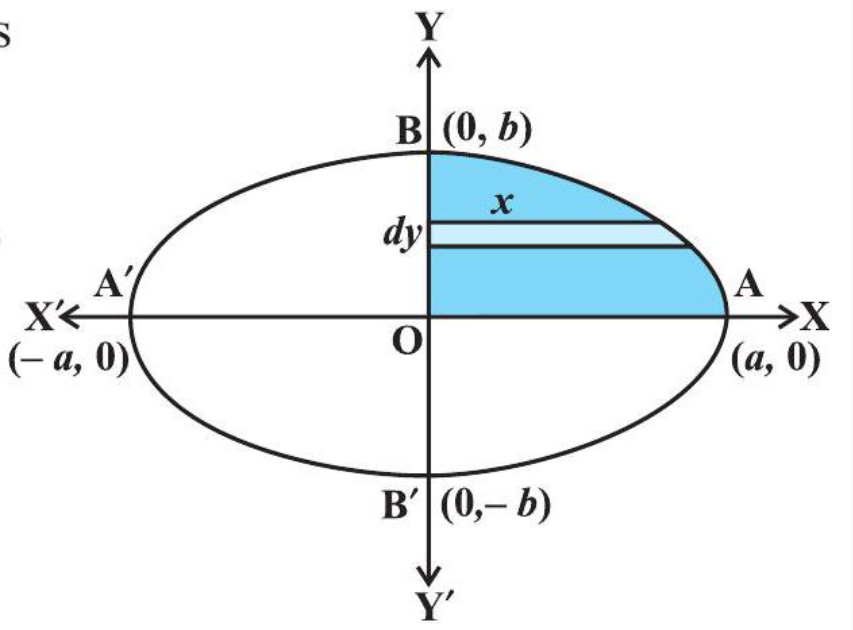
Fig 8.8
EXERCISE 8.1
1. Find the area of the region bounded by the ellipse $\frac{x^{2}}{16}+\frac{y^{2}}{9}=1$.
Show Answer
Solution
The given equation of the ellipse, $\frac{x^{2}}{16}+\frac{y^{2}}{9}=1$, can be represented as
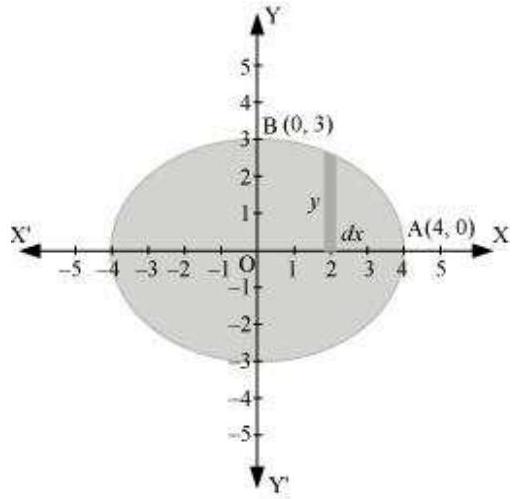
It can be observed that the ellipse is symmetrical about $x$-axis and $y$-axis.
$\therefore$ Area bounded by ellipse $=4 \times$ Area of OAB
$ \begin{aligned} \text{ Area of } OAB & =\int_0^{4} y d x \\ & =\int_0^{4} 3 \sqrt{1-\frac{x^{2}}{16}} d x \\ & =\frac{3}{4} \int_0^{4} \sqrt{16-x^{2}} d x \\ & =\frac{3}{4}[\frac{x}{2} \sqrt{16-x^{2}}+\frac{16}{2} \sin ^{-1} \frac{x}{4}]_0^{4} \\ & =\frac{3}{4}[2 \sqrt{16-16}+8 \sin ^{-1}(1)-0-8 \sin ^{-1}(0)] \\ & =\frac{3}{4}[\frac{8 \pi}{2}] \\ & =\frac{3}{4}[4 \pi] \\ & =3 \pi \end{aligned} $
Therefore, area bounded by the ellipse $=4 \times 3\pi =12 \pi$ units
2. Find the area of the region bounded by the ellipse $\frac{x^{2}}{4}+\frac{y^{2}}{9}=1$.
Show Answer
Solution
The given equation of the ellipse can be represented as
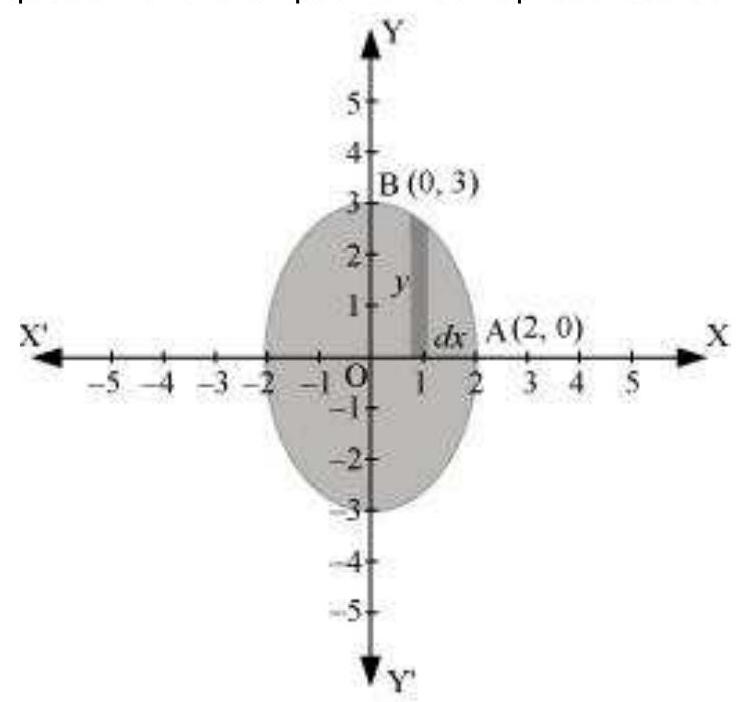
$\frac{x^{2}}{4}+\frac{y^{2}}{9}=1$
$\Rightarrow y=3 \sqrt{1-\frac{x^{2}}{4}}$
It can be observed that the ellipse is symmetrical about $x$-axis and $y$-axis.
$\therefore$ Area bounded by ellipse $=4 \times$ Area OAB $\therefore$ Area of $OAB=\int_0^{2} y d x$
$ \begin{aligned} & =\int_0^{2} 3 \sqrt{1-\frac{x^{2}}{4}} d x \quad \text{ [Using (1)] } \\ & =\frac{3}{2} \int_0^{2} \sqrt{4-x^{2}} d x \\ & =\frac{3}{2}[\frac{x}{2} \sqrt{4-x^{2}}+\frac{4}{2} \sin ^{-} \frac{x}{2}]_0^{2} \\ & =\frac{3}{2}[\frac{2 \pi}{2}] \\ & =\frac{3 \pi}{2} \end{aligned} $
Therefore, area bounded by the ellipse $=4 \times \frac{3 \pi}{2}=6 \pi$ units
Choose the correct answer in the following Exercises 3 and 4.
3. Area lying in the first quadrant and bounded by the circle $x^{2}+y^{2}=4$ and the lines $x=0$ and $x=2$ is
$\quad\quad$(A) $\pi$
$\quad\quad$(B) $\frac{\pi}{2}$
$\quad\quad$(C) $\frac{\pi}{3}$
$\quad\quad$(D) $\frac{\pi}{4}$
Show Answer
Solution
The area bounded by the circle and the lines, $x=0$ and $x=2$, in the first quadrant is represented as
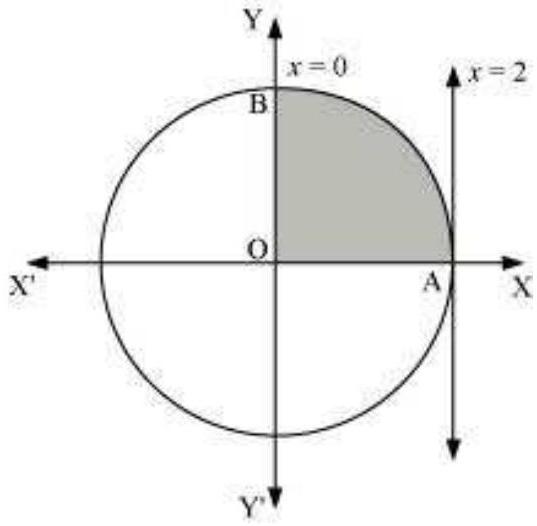
$ \begin{aligned} \therefore \text{ Area OAB } & =\int_0^{2} y d x \\ & =\int_0^{2} \sqrt{4-x^{2}} d x \\ & =[\frac{x}{2} \sqrt{4-x^{2}}+\frac{4}{2} \sin ^{-1} \frac{x}{2}]_0^{2} \\ & =2(\frac{\pi}{2}) \\ & =\pi \text{ units } \end{aligned} $
Thus, the correct answer is $A$.
4. Area of the region bounded by the curve $y^{2}=4 x, y$-axis and the line $y=3$ is
$\quad\quad$(A) 2
$\quad\quad$(B) $\frac{9}{4}$
$\quad\quad$(C) $\frac{9}{3}$
$\quad\quad$(D) $\frac{9}{2}$
Show Answer
Solution
The area bounded by the curve, $y^{2}=4 x, y$-axis, and $y=3$ is represented as
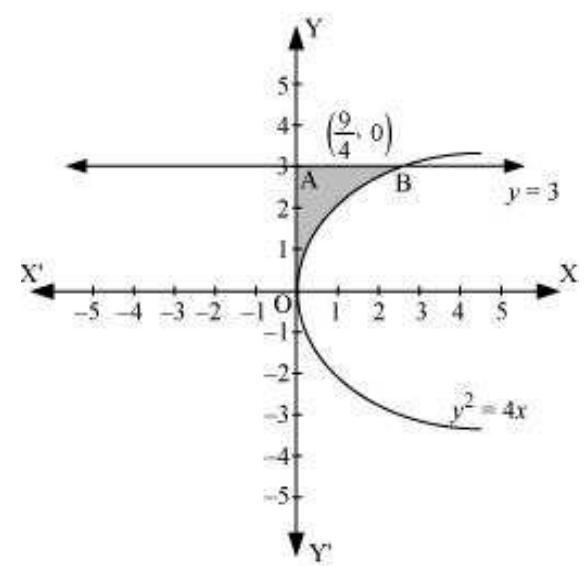
$\therefore$ Area $OAB=\int_0^{3} x d y$
$ =\int_0^{3} \frac{y^{2}}{4} d y $
$ \begin{aligned} & =\frac{1}{4}[\frac{y^{3}}{3}]_0^{3} \\ & =\frac{1}{12}(27) \\ & =\frac{9}{4} \text{ units } \end{aligned} $
Thus, the correct answer is $B$.
Miscellaneous Examples
Example 3 Find the area of the region bounded by the line $y=3 x+2$, the $x$-axis and the ordinates $x=-1$ and $x=1$.
Solution As shown in the Fig 8.9, the line $y=3 x+2$ meets $x$-axis at $x=\frac{-2}{3}$ and its graph lies below $x$-axis for $x \in(-1, \frac{-2}{3})$ and above $x$-axis for $x \in(\frac{-2}{3}, 1)$.
The required area $=$ Area of the region $ACBA+$ Area of the region ADEA
$ \begin{aligned} & =|\int _{-1}^{\frac{-2}{3}}(3 x+2) d x|+\int _{\frac{-2}{3}}^{1}(3 x+2) d x \\ & =|[\frac{3 x^{2}}{2}+2 x] _{-1}^{\frac{-2}{3}}|+[\frac{3 x^{2}}{2}+2 x] _{\frac{-2}{3}}^{1}=\frac{1}{6}+\frac{25}{6}=\frac{13}{3} \end{aligned} $

Fig 8.9
Example 4 Find the area bounded by the curve $y=\cos x$ between $x=0$ and $x=2 \pi$.
Solution From the Fig 8.10, the required area $=$ area of the region $OABO+$ area of the region $BCDB+$ area of the region DEFD.

Fig 8.10
Thus, we have the required area
$ \begin{aligned} & =\int_ 0^{\frac{\pi}{2}} \cos x d x+|\int_ {\frac{\pi}{2}}^{\frac{3 \pi}{2}} \cos x d x|+\int_ {\frac{3 \pi}{2}}^{2 \pi} \cos x d x \\ & =[\sin x]_ 0^{\frac{\pi}{2}}+|[\sin x]_ {\frac{\pi}{2}}^{\frac{3 \pi}{2}}|+[\sin x]_ {\frac{3 \pi}{2}}^{2 \pi} \\ & =1+2+1=4 \end{aligned} $
Miscellaneous Exercise on Chapter 8
1. Find the area under the given curves and given lines:
$\quad\quad$(i) $y=x^{2}, x=1, x=2$ and $x$-axis
$\quad\quad$(ii) $y=x^{4}, x=1, x=5$ and $x$-axis
Show Answer
Solution
i. The required area is represented by the shaded area ADCBA as
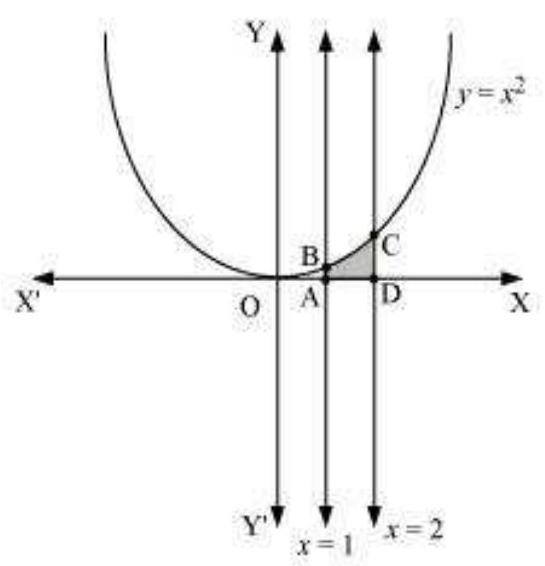
$ \begin{aligned} \text{ Area ADCBA } & =\int_1^{2} y d x \\ & =\int_1^{2} x^{2} d x \\ & =[\frac{x^{3}}{3}]_1^{2} \\ & =\frac{8}{3}-\frac{1}{3} \\ & =\frac{7}{3} \text{ units } \end{aligned} $
ii. The required area is represented by the shaded area ADCBA as
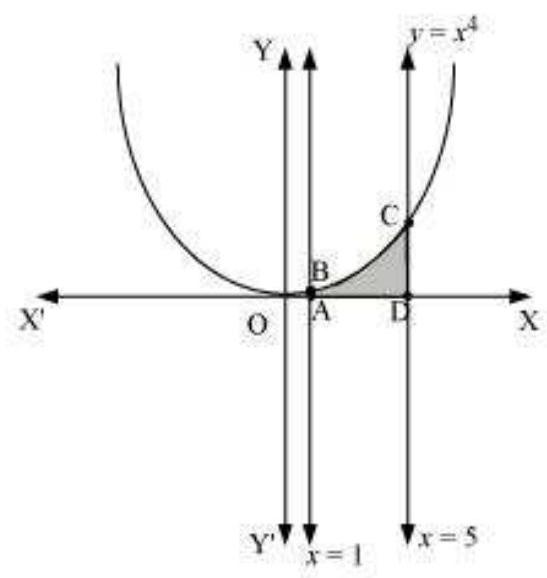
$ \begin{aligned} \text{ Area ADCBA } & =\int_1^{5} x^{4} d x \\ & =[\frac{x^{5}}{5}]_1^{5} \\ & =\frac{(5)^{5}}{5}-\frac{1}{5} \\ & =(5)^{4}-\frac{1}{5} \\ & =625-\frac{1}{5} \\ & =624.8 \text{ units } \end{aligned} $
2. Sketch the graph of $y=|x+3|$ and evaluate $\int _{-6}^{0}|x+3| d x$.
Show Answer
Solution
The given equation is $y=|x+3|$
The corresponding values of $x$ and $y$ are given in the following table.
| $x$ | -6 | -5 | -4 | -3 | -2 | -1 | 0 |
|---|---|---|---|---|---|---|---|
| $y$ | 3 | 2 | 1 | 0 | 1 | 2 | 3 |
On plotting these points, we obtain the graph of $y=|x+3|$ as follows.
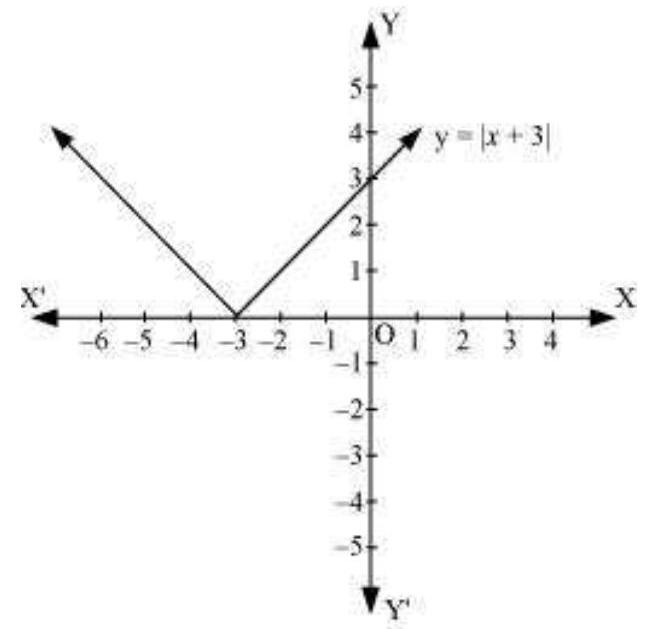
It is known that, $(x+3) \leq 0$ for $-6 \leq x \leq-3$ and $(x+3) \geq 0$ for $-3 \leq x \leq 0$
$ \begin{aligned} \therefore \int _{-6}^{0}|(x+3)| d x & =-\int _{-6}^{-3}(x+3) d x+\int _{-3}^{0}(x+3) d x \\ & =-[\frac{x^{2}}{2}+3 x] _{-6}^{-3}+[\frac{x^{2}}{2}+3 x] _{-3}^{0} \\ & =-[(\frac{(-3)^{2}}{2}+3(-3))-(\frac{(-6)^{2}}{2}+3(-6))]+[0-(\frac{(-3)^{2}}{2}+3(-3)]] \\ & =-[-\frac{9}{2}]-[-\frac{9}{2}] \\ & =9 \end{aligned} $
3. Find the area bounded by the curve $y=\sin x$ between $x=0$ and $x=2 \pi$.
Show Answer
Solution
The graph of $y=\sin x$ can be drawn as
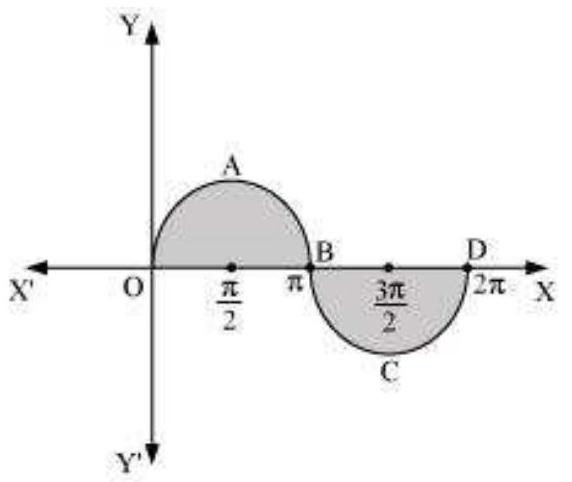
$\therefore$ Required area $=$ Area $OABO+$ Area $BCDB$
$ \begin{aligned} & =\int_0^{\pi} \sin x d x+|\int _{\pi}^{2 \pi} \sin x d x| \\ & =[-\cos x]_0^{\pi}+|[-\cos x] _{\pi}^{2 \pi}| \\ & =[-\cos \pi+\cos 0]+|-\cos 2 \pi+\cos \pi| \\ & =1+1+|(-1-1)| \\ & =2+|-2| \\ & =2+2=4 \text{ units } \end{aligned} $
Choose the correct answer in the following Exercises from 4 to 5.
4. Area bounded by the curve $y=x^{3}$, the $x$-axis and the ordinates $x=-2$ and $x=1$ is
$\quad\quad$(A) -9
$\quad\quad$(B) $\frac{-15}{4}$
$\quad\quad$(C) $\frac{15}{4}$
$\quad\quad$(D) $\frac{17}{4}$
Show Answer
Solution
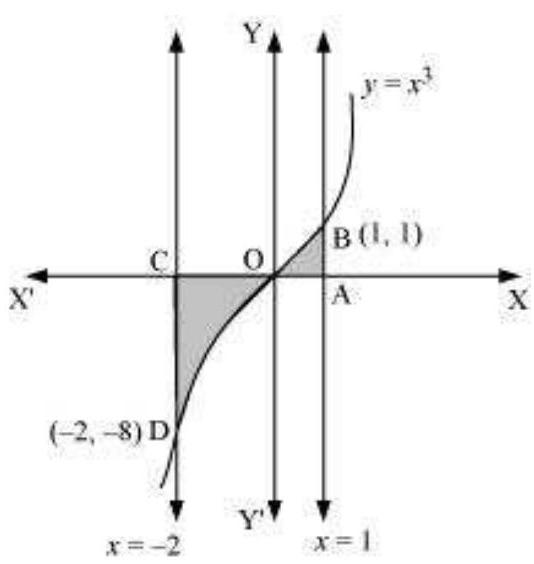
Required area $=\int _{-2}^{1} y d x$
1- Identify positive and negative areas:
- We know the curve dips below the x-axis between x = -2 and x = 0 (roughly at the point where x = -1).
- So, we’ll calculate the area under the curve in two sections:
- Area above the x-axis: from x = 0 to x = 1 (positive)
- Area below the x-axis: from x = -2 to x = 0 (negative)
2- Set up definite integrals:
- Area above the x-axis: ∫₀¹ (x^3) dx
- Area below the x-axis: ∫-20 (x^3) dx (notice the negative sign here to account for the area below the x-axis)
3- Evaluate the integrals: Following the same steps as before using the power rule of integration:
- Area above the x-axis: [(x^4)/4]₀¹ = (1/4)
- Area below the x-axis: |[(-x^4)/4]₋²⁰| = (16/4) (absolute value to consider the positive area enclosed below the x-axis)
4- Calculate the net enclosed area:
- Net Enclosed Area = Area above the x-axis+ Area below the x-axis = (1/4) + (16/4) = 17/4
The correct option is D.
5. The area bounded by the curve $y=x|x|, x$-axis and the ordinates $x=-1$ and $x=1$ is given by
$\quad\quad$(A) 0
$\quad\quad$(B) $\frac{1}{3}$
$\quad\quad$(C) $\frac{2}{3}$
$\quad\quad$(D) $\frac{4}{3}$
[Hint : $y=x^{2}$ if $x>0$ and $y=-x^{2}$ if $.x<0$].
Show Answer
Solution

Required area $=\int _{-1}^{1} y d x$
$=-\int _{-1}^{1} x|x| d x$
$=-\int _{-1}^{0} x^{2} d x+\int_0^{1} x^{2} d x$
$=-[\frac{x^{3}}{3}] _{-1}^{0}+[\frac{x^{3}}{3}]_0^{1}$
$=-(-\frac{1}{3})+\frac{1}{3}$
$=\frac{2}{3}$ units
Thus, the correct answer is C.
Summary
The area of the region bounded by the curve $y=f(x), x$-axis and the lines $x=a$ and $x=b(b>a)$ is given by the formula: Area $=\int_a^{b} y d x=\int_a^{b} f(x) d x$. The area of the region bounded by the curve $x=\phi(y), y$-axis and the lines $y=c, y=d$ is given by the formula: Area $=\int_c^{d} x d y=\int_c^{d} \phi(y) d y$.
Historical Note
The origin of the Integral Calculus goes back to the early period of development of Mathematics and it is related to the method of exhaustion developed by the mathematicians of ancient Greece. This method arose in the solution of problems on calculating areas of plane figures, surface areas and volumes of solid bodies etc. In this sense, the method of exhaustion can be regarded as an early method of integration. The greatest development of method of exhaustion in the early period was obtained in the works of Eudoxus (440 B.C.) and Archimedes (300 B.C.)
Systematic approach to the theory of Calculus began in the 17th century. In 1665, Newton began his work on the Calculus described by him as the theory of fluxions and used his theory in finding the tangent and radius of curvature at any point on a curve. Newton introduced the basic notion of inverse function called the anti derivative (indefinite integral) or the inverse method of tangents.
During 1684-86, Leibnitz published an article in the Acta Eruditorum which he called Calculas summatorius, since it was connected with the summation of a number of infinitely small areas, whose sum, he indicated by the symbol ’ ’ ‘. In 1696 , he followed a suggestion made by J. Bernoulli and changed this article to Calculus integrali. This corresponded to Newton’s inverse method of tangents.
Both Newton and Leibnitz adopted quite independent lines of approach which was radically different. However, respective theories accomplished results that were practically identical. Leibnitz used the notion of definite integral and what is quite certain is that he first clearly appreciated tie up between the antiderivative and the definite integral.
Conclusively, the fundamental concepts and theory of Integral Calculus and primarily its relationships with Differential Calculus were developed in the work of P.de Fermat, I. Newton and G. Leibnitz at the end of 17th century. However, this justification by the concept of limit was only developed in the works of A.L. Cauchy in the early 19th century. Lastly, it is worth mentioning the following quotation by Lie Sophie’s:
“It may be said that the conceptions of differential quotient and integral which in their origin certainly go back to Archimedes were introduced in Science by the investigations of Kepler, Descartes, Cavalieri, Fermat and Wallis …. The discovery that differentiation and integration are inverse operations belongs to Newton and Leibnitz”.










